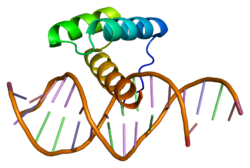Top Qs
Timeline
Chat
Perspective
Msh homeobox 2
Protein-coding gene in the species Homo sapiens From Wikipedia, the free encyclopedia
Remove ads
Homeobox protein MSX-2 is a protein that in humans is encoded by the MSX2 gene.[4][5][6]
Remove ads
Function
This gene encodes a member of the muscle segment homeobox gene family. The encoded protein is a transcriptional repressor whose normal activity may establish a balance between survival and apoptosis of neural crest-derived cells required for proper craniofacial morphogenesis. The encoded protein may also have a role in promoting cell growth under certain conditions and may be an important target for the RAS signaling pathways. Mutations in this gene are associated with parietal foramina 1 and craniosynostosis type 2.[6] Msx2 is a homeobox gene localized on human chromosome 5 that encodes a transcription repressor and activator (MSX-2) responsible for craniofacial and limb-bud development. Cells will express msx2 when exposed to signaling molecules BMP-2 and BMP-4 in situ.[7] It is well documented that expression of cell-cell adhesion molecules such as E-cadherins will promote structural integrity and an epithelial arrangement of cells, while expression of N-cadherin and vimentin promote mesenchymal arrangement and cell migration.[8][9] Msx2 downregulates E-cadherins and upregulates N-cadherin and vimentin which indicates its role in inducing epithelial mesenchymal transition (EMT). Germline knockout mice have been created for this gene (Msx2 +/-) in order to examine functional loss.[10] Clinical studies on craniosynostosis, or the premature fusion of cranial structures, have shown the condition to be genetically linked to mutation in the msx2 homeobox gene.[11]
Remove ads
Interactions
Msh homeobox 2 has been shown to interact with DLX5,[12] DLX2[12] and MSX1.[12]
References
Further reading
External links
Wikiwand - on
Seamless Wikipedia browsing. On steroids.
Remove ads





